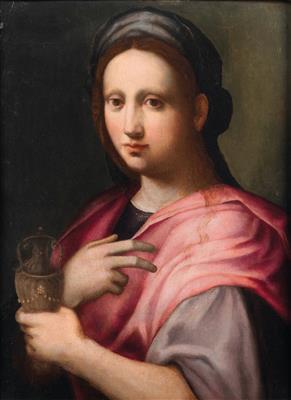Domenico Puligo

(Florence 1492–1527)
Saint Mary Magdalene holding an ointment vessel,
oil on panel, 57.5 x 43.5 cm, framed
Provenance:
possibly collection of the de Marinis family, Marches of Genzano, Naples;
possibly by inheritance to the collection of the de Sangro family, Princes of Fondi;
Private European collection
The attribution of the present painting has been confirmed by Elena Capretti (written communication, in copy).
According to Elena Capretti, this painting belonged to the collection of the de Marinis family, which extinguished in the de Sangro family in the nineteenth century.
The present work reveals striking similarities to the Magdalene in the Accademia Albertina, Turin, which is datable to 1520 (see G. Garrone in: F. Dalmasso et al. (eds.), Le Arti del disegno all’Accademia Albertina, Turin 1995, pp. 44-45). Other similarities can be seen in comparisons with the Magdalene in the Galleria Borghese, as well as with other sacred subjects by the artist, such as the Madonna and Child with Saint John the Baptist in the Galleria Palatina, Florence (see E. Capretti/S. Padovani, Domenico Puligo (1492-1527). Un protagonista dimenticato della pittura fiorentina, Livorno 2002, pp. 44-51, 82-83).
In the present composition Mary Magdalene is depicted in half-length, three-quarter view, with her hair tied up in a veil, and her gaze turned upon the viewer. She raises her right hand to her breast, while with her left she holds the vase. She is represented according to the mirrofora iconographic tradition, wherein the saint is shown holding a vase that contained myrrh, the ointment brought by the Magi as a gift to Christ, and that which the Three Marys, brought with them to the Holy Sepulchre. This subject is recurrent in Domenico Puligo’s oeuvre. The idealised rendering of the subject and the saint’s melancholy gaze with her features sculpturally modelled by the light, are typical elements of Puligo’s pictorial language. The effect of sfumato, derived from Leonardo, lends a softness of form that contributes to infusing the work with a poetically atmosphere.
Domenico Puligo trained in the studio of Ridolfo del Ghirlandaio and he became friends with Andrea del Sarto who influenced his style of painting. Puligo specialised in painting dipinti da camera for private patrons, such as portraits and representations of the Madonna and of Saints. In his Vite Giorgio Vasari recognised the artist’s distinctive style, by which he was accorded fame, observing his ‘dolcezza’ [‘sweetness’], his ‘colorito vago e grazioso’ [‘fine and graceful palette’] and that ‘certa nebia’ [‘certain mist’] that veiled his figures giving them ‘rilievo e grazia’ [‘relief and grace’] (see G. Vasari, Le Vite de’ più eccellenti pittori, scultori ed architettori…, Florence 1568, ed. by G. Milanesi, Florence 1879, vol. IV, pp. 461-468).
23.10.2018 - 18:00
- Estimate:
-
EUR 25,000.- to EUR 35,000.-
Domenico Puligo
(Florence 1492–1527)
Saint Mary Magdalene holding an ointment vessel,
oil on panel, 57.5 x 43.5 cm, framed
Provenance:
possibly collection of the de Marinis family, Marches of Genzano, Naples;
possibly by inheritance to the collection of the de Sangro family, Princes of Fondi;
Private European collection
The attribution of the present painting has been confirmed by Elena Capretti (written communication, in copy).
According to Elena Capretti, this painting belonged to the collection of the de Marinis family, which extinguished in the de Sangro family in the nineteenth century.
The present work reveals striking similarities to the Magdalene in the Accademia Albertina, Turin, which is datable to 1520 (see G. Garrone in: F. Dalmasso et al. (eds.), Le Arti del disegno all’Accademia Albertina, Turin 1995, pp. 44-45). Other similarities can be seen in comparisons with the Magdalene in the Galleria Borghese, as well as with other sacred subjects by the artist, such as the Madonna and Child with Saint John the Baptist in the Galleria Palatina, Florence (see E. Capretti/S. Padovani, Domenico Puligo (1492-1527). Un protagonista dimenticato della pittura fiorentina, Livorno 2002, pp. 44-51, 82-83).
In the present composition Mary Magdalene is depicted in half-length, three-quarter view, with her hair tied up in a veil, and her gaze turned upon the viewer. She raises her right hand to her breast, while with her left she holds the vase. She is represented according to the mirrofora iconographic tradition, wherein the saint is shown holding a vase that contained myrrh, the ointment brought by the Magi as a gift to Christ, and that which the Three Marys, brought with them to the Holy Sepulchre. This subject is recurrent in Domenico Puligo’s oeuvre. The idealised rendering of the subject and the saint’s melancholy gaze with her features sculpturally modelled by the light, are typical elements of Puligo’s pictorial language. The effect of sfumato, derived from Leonardo, lends a softness of form that contributes to infusing the work with a poetically atmosphere.
Domenico Puligo trained in the studio of Ridolfo del Ghirlandaio and he became friends with Andrea del Sarto who influenced his style of painting. Puligo specialised in painting dipinti da camera for private patrons, such as portraits and representations of the Madonna and of Saints. In his Vite Giorgio Vasari recognised the artist’s distinctive style, by which he was accorded fame, observing his ‘dolcezza’ [‘sweetness’], his ‘colorito vago e grazioso’ [‘fine and graceful palette’] and that ‘certa nebia’ [‘certain mist’] that veiled his figures giving them ‘rilievo e grazia’ [‘relief and grace’] (see G. Vasari, Le Vite de’ più eccellenti pittori, scultori ed architettori…, Florence 1568, ed. by G. Milanesi, Florence 1879, vol. IV, pp. 461-468).
|
Buyers hotline
Mon.-Fri.: 10.00am - 5.00pm
old.masters@dorotheum.at +43 1 515 60 403 |
| Auction: | Old Master Paintings |
| Auction type: | Saleroom auction |
| Date: | 23.10.2018 - 18:00 |
| Location: | Vienna | Palais Dorotheum |
| Exhibition: | 13.10. - 23.10.2018 |
